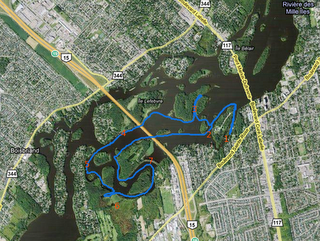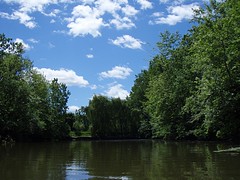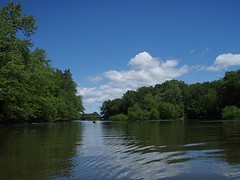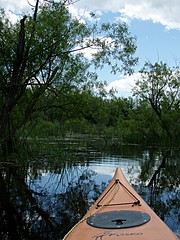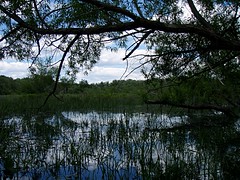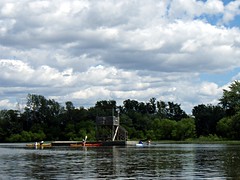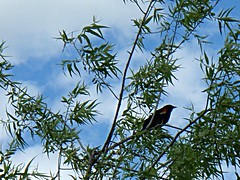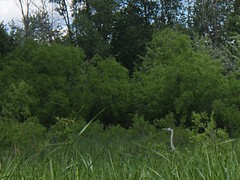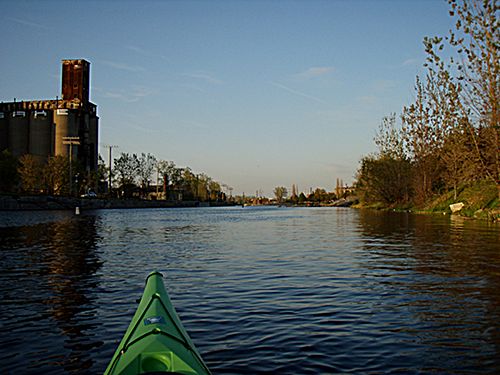Cross-posted from Kayak Yak.
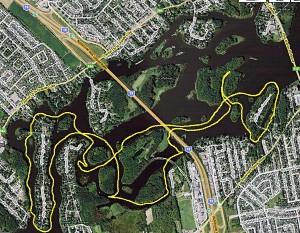 Perfect days don’t just happen in the West Coast Paddling Paradise – sometimes they happen here in the east. Today’s forecast was for calm until the afternoon, then 10-15 knot SW winds, and a high of 25 C, and that is exactly what I got on today’s trip to Parc de la Rivière-des-Mille-Îles (actually my fourth). Despite a technical hitch involving my Opus (Metro) card and a missed train, I was at Cartier station in plenty of time to catch the 0829 #73 bus and discovered to my pleasure that the #73 was no longer on diversion prior to the Parc, the resurfacing on pont Marius Defresne (the right-most bridge on the map) having migrated south of the intersection with boulevard Ste-Rose . I alighted at the Parc gates, was just about first up to the counter to rent a kayak de mer, and paid attention to the paddle (feathered), the seat (snugly fitting with solid back support) and the footrests (adjusted to my height), all of which I’d neglected to check the last time I was out (last Monday). I let myself drift off the dock while I made sure I found the panorama settings on the Olympus waterproof – I’d decided that traveling with two point and shoot digitals and one film camera was maybe a little excessive. Then I headed north-east out of the entrance of the lagoon, around the tip of Île Gagnon on water that was so glassy the kayak just slip-slid along, every so often twitching with a fillup of river-current. The skin of the water was alive with tiny water-beetles, like tossed handfuls of blue-black seed-beads.
Perfect days don’t just happen in the West Coast Paddling Paradise – sometimes they happen here in the east. Today’s forecast was for calm until the afternoon, then 10-15 knot SW winds, and a high of 25 C, and that is exactly what I got on today’s trip to Parc de la Rivière-des-Mille-Îles (actually my fourth). Despite a technical hitch involving my Opus (Metro) card and a missed train, I was at Cartier station in plenty of time to catch the 0829 #73 bus and discovered to my pleasure that the #73 was no longer on diversion prior to the Parc, the resurfacing on pont Marius Defresne (the right-most bridge on the map) having migrated south of the intersection with boulevard Ste-Rose . I alighted at the Parc gates, was just about first up to the counter to rent a kayak de mer, and paid attention to the paddle (feathered), the seat (snugly fitting with solid back support) and the footrests (adjusted to my height), all of which I’d neglected to check the last time I was out (last Monday). I let myself drift off the dock while I made sure I found the panorama settings on the Olympus waterproof – I’d decided that traveling with two point and shoot digitals and one film camera was maybe a little excessive. Then I headed north-east out of the entrance of the lagoon, around the tip of Île Gagnon on water that was so glassy the kayak just slip-slid along, every so often twitching with a fillup of river-current. The skin of the water was alive with tiny water-beetles, like tossed handfuls of blue-black seed-beads.
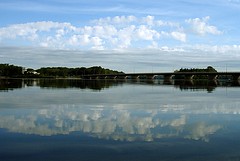 Pausing frequently to take photographs, I moseyed up in the direction of the wetlands area I’d discovered in my first trip back in July. At the time I set out, the sun was filtered by a thin film of cirrostratus, with denser streaks of cirrocumulus; it looked like the weather was changing, but by the time I reached the wetlands, the cirrostratus had cleared and the sun was alternating bright sunshine with the shadow of small cumuli, and in the four and a half hours I was out, the clouds – small cumuli and cirus – gathered and dispersed several times, none of the clouds dense or substantial enough to more than dim the sunlight. The wind, as forecast, did not pick up until close to noon, at which point I was paddling south against the current on the west side of Île de Mai, the long island running north-south at the left of the map.
Pausing frequently to take photographs, I moseyed up in the direction of the wetlands area I’d discovered in my first trip back in July. At the time I set out, the sun was filtered by a thin film of cirrostratus, with denser streaks of cirrocumulus; it looked like the weather was changing, but by the time I reached the wetlands, the cirrostratus had cleared and the sun was alternating bright sunshine with the shadow of small cumuli, and in the four and a half hours I was out, the clouds – small cumuli and cirus – gathered and dispersed several times, none of the clouds dense or substantial enough to more than dim the sunlight. The wind, as forecast, did not pick up until close to noon, at which point I was paddling south against the current on the west side of Île de Mai, the long island running north-south at the left of the map.
I’ve been out four times now, twice in July, once at the end of August, and today. The water-level has appreciably dropped, such that the flooded stand of silver maples I got to paddle through in July (nourishing the resident flies in the process) were quite dry and aloof to the water now, and the hairpin between Île des Jiufs (how I read it on the map) and Île aux Fraises (both north-west of Île Gagnon) was because I got all the way through and found the channel blocked by a ridge of toothy boulders and the branches and debris they had strained out. A large culvert beneath the peninsula that carries the autoroute des Laurentides (the second river-spanning bridge) was also impassible due to a snag. I had more scrapes and grounded out my paddle more often today; on the up-side, a summer’s growth had brought the weeds very close to the surface, though they were too thick with algae and mud for me to recognize more than ribbon-shape or branching brush-shape. And as I paddled down to the south of Île Lacroix (just east of the marshlands) on my return I was able to look down and see schools of tiddlers scattering at the vibrations of my passage.
I’d meant to go into the marshlands, as I did in July, but there was a great blue heron fishing in the shallows just beside the one barely navigable channel – I’d made it a little way up that channel on my last outing, but between the water level sinking and the summer’s growth of reeds and weed, it was only a little way. So I stood off and watched the heron prowl along the edge of the reeds. There is something catlike about them, with the stillness, the hunkering low, the pounce – and the little ruffled insouciant shiver as they collect themselves after a failed strike. There were ducks aplenty, mainly mallards, browsing in pairs and more often than not standing tails to heaven in the still waters. I caught sight of a single kingfisher, a flash of white against the trees, and later on saw two flying between islands, squabbling all the way – are they territorial birds?
After the wetlands, I wanted to circumnavigate Île de Mai, the recommended way this time. The second trip I made in July, I looped out on the west side of the island and nearly did not make it, hitting what I suspect was an underwater bar within sight of the end. It was also the day after severe thunderstorms, when the water was murky brown and running fast, and there were downed and split trees all along the channel. I came to a standstill, paddling full-force, and had given up and was drifting downstream when in a fit of cussedness I decided to try the other side, crossed over, and succeeded in paddling through the stall, though literally gaining an inch at a time at one point. I was consoled that a two-person canoe whom I passed on my downstream drift, wound up doing exactly the same. It wasn’t until I got back that I looked at the Parc guide and saw that the marked route went up the east side and came down the west. So this time I did it the easy way. No stalls, though some churning water off Île aux Moutons (the small island north east of Île de Mai, and definite current, then wind. A small culvert underneath that promontory was open this time, and I paddled against the wind and the current up to the open waters, where the powerboats were churning in circles. Those coming through the channel kept their speed down, with one exception, a white powerboat that came crashing past Île de Moutons as I was starting up the channel, steering between a pair of kayaks. The buzzed kayakers coped all right, but a couple of others in the vicinity were visibly uneasy being bounced around in the reflected waves.
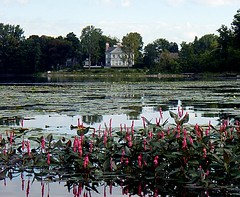 Having made it to the tip of Île de Mai, I got to ride down with the wind and current, and when I hit the point I’d hung up before, I got a brisk kick from behind, much easier going north than south. I needed a pit-stop, so I turned back to Île Chabon, which was marked on the map as having latrines, and, since there was no helpful signposting, walked three quarters of the way round the island before finding the sign and the hutch in the wood (with toilet paper, too). On the sunny side of Île Chabon, the turtles were out once again, warming themselves on fallen logs and rocks; I still don’t know what kind they are, not having been allowed close enough. Then I headed down through the weed-clogged channel south of Île Lacroix, tiddler-spotting and being buzzed by dragonflies, large black and smaller bright blue. Ducked under the bridge to Île Locas, avoiding fishing-lines slung from the bridge, and under the long autoroute de Laurentides bridge. Decided that I was not going to make it back within the four hour mark and I might as well be hanged for a sheep, etc, so detoured across to try and navigate the channel between Île de Juifs and Île aux Fraises, and found it blocked, so I then doubled back around the western tip of Île Gagnon, under a bridge into the lagoon, and found it milling with boats as the holiday monday afternoon canoists and kayakers and peddle-boaters all turned out. Lingered in the Interpretation Centre until my (hourly) bus was due, puzzling out the descriptions of the river milieu in French and writing down names of plants to look up. Aside from the water-lilies, one of the water-weeds was flowering, small dense pink flowers on conical stalks, forming mats along the edges of the reeds, downstream from the islands, and even at shallow points in the middle of channels.
Having made it to the tip of Île de Mai, I got to ride down with the wind and current, and when I hit the point I’d hung up before, I got a brisk kick from behind, much easier going north than south. I needed a pit-stop, so I turned back to Île Chabon, which was marked on the map as having latrines, and, since there was no helpful signposting, walked three quarters of the way round the island before finding the sign and the hutch in the wood (with toilet paper, too). On the sunny side of Île Chabon, the turtles were out once again, warming themselves on fallen logs and rocks; I still don’t know what kind they are, not having been allowed close enough. Then I headed down through the weed-clogged channel south of Île Lacroix, tiddler-spotting and being buzzed by dragonflies, large black and smaller bright blue. Ducked under the bridge to Île Locas, avoiding fishing-lines slung from the bridge, and under the long autoroute de Laurentides bridge. Decided that I was not going to make it back within the four hour mark and I might as well be hanged for a sheep, etc, so detoured across to try and navigate the channel between Île de Juifs and Île aux Fraises, and found it blocked, so I then doubled back around the western tip of Île Gagnon, under a bridge into the lagoon, and found it milling with boats as the holiday monday afternoon canoists and kayakers and peddle-boaters all turned out. Lingered in the Interpretation Centre until my (hourly) bus was due, puzzling out the descriptions of the river milieu in French and writing down names of plants to look up. Aside from the water-lilies, one of the water-weeds was flowering, small dense pink flowers on conical stalks, forming mats along the edges of the reeds, downstream from the islands, and even at shallow points in the middle of channels.
More photographs to follow in my Flickr collection. For now, I must acknowledge the imminence of Tuesday.

